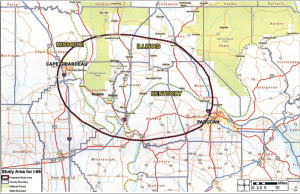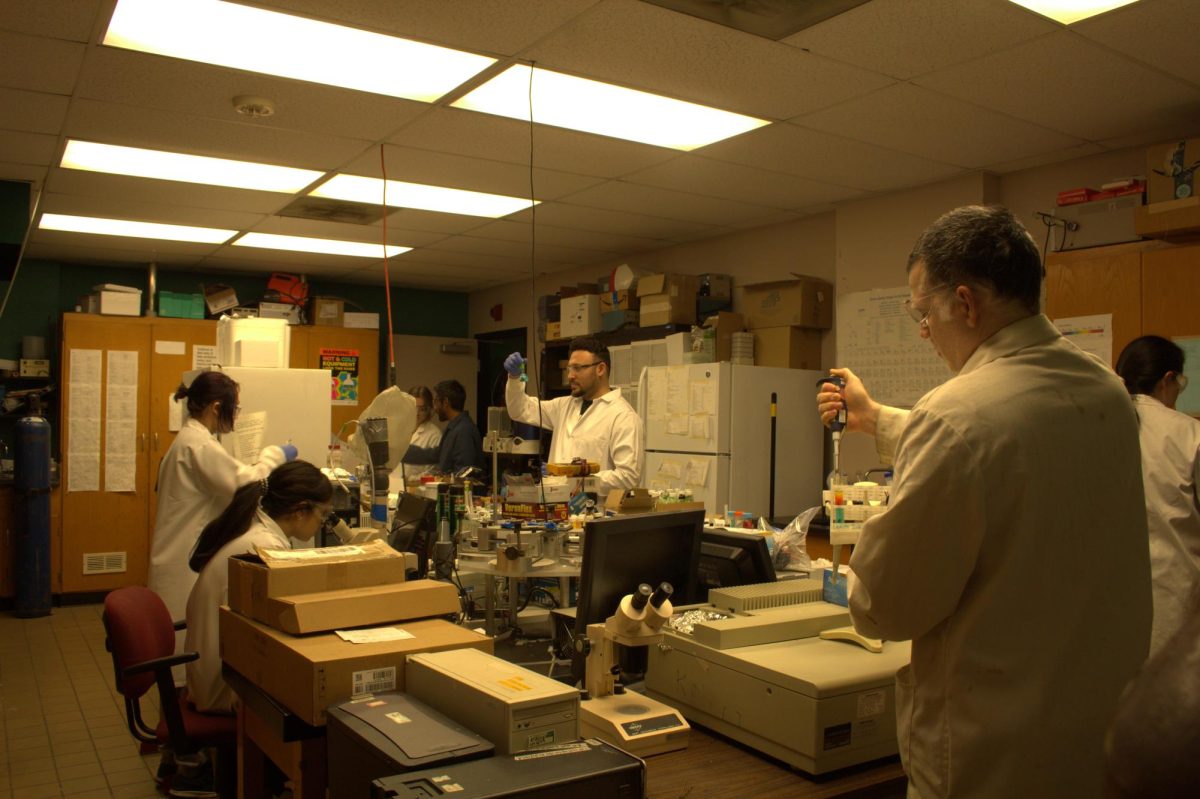This way to Paducah

January 23, 2013
A study for a possible southern Illinois interstate has metropolitan representatives salivating and environmentalists sweating.
The study is for proposed Interstate 66, which would run through southernmost Illinois from Paducah, Ky., to Cape Girardeau, Mo. With a $3.5 million grant from the federal government and a 20 percent match from the Illinois Department of Transportation, the $4.5 million study will begin by February or March and last around three years, said Carrie Nelsen, district 9 program development engineer for IDOT.
The feasibility study’s goal is to determine where the interstate would best be placed, and counties taken under consideration include Alexander, Johnson, Massac, Pulaski and Union.
Advertisement
According to IDOT’s website, the road should open economic development opportunities; improve accessibility to employment, higher education, retail/shopping and medical services; increase Shawnee National Forest tourism; improve highway safety to traveling public; and reduce travel time and vehicle operating costs between Paducah and Cape.
Elaine Spalding, president of the Paducah Chamber of Commerce, said the interstate is needed so the two cities can be connected by an east/west route.
“There’s just no good way to get from Paducah to Cape Girardeau right now,” she said. “Some people take the northern route, some take the southern, and it’s just a really lengthy drive either way you go. This will link our communities so we can have more business-to-business and business-to- consumer traffic … and continue to promote the entire region.”
Representatives from Cape Girardeau, Paducah and IDOT say the interstate could greatly enhance economic development not only in the metropolitan cities but also in southern Illinois. They say it will generate road
employment, and businesses will pop up on the route’s outskirts.
However, some southern Illinoisans argue that the area’s already struggling economy will suffer more when chain restaurants and gas stations take away from local businesses
Others are concerned the interstate will impact important natural resources such as the Shawnee National Forest and the Cache River Wetlands. Because of their importance to migratory waterfowl and shorebirds, the wetlands, specifically, are designated Wetlands of National Importance — only one of 22 in the nation, according to the Illinois Department of Natural Resources. The area contains more than 100 threatened and endangered species
Advertisement*
into a wildlife habitat, including wetlands, grass prairie, natural woods, trails, bridges and creeks.
He said he’s very concerned the interstate will increase revenue to Cape and Paducah but take away from the smaller towns in between.
“They end up with an isolation situation where the highway skirts around (small towns) and all the potential business is taken out of the cities,” Shaffer said. “We’re giving up a lot of our ability to develop revenue, and we’re sending it all to either Paducah or Cape Girardeau.”
Jonesboro has mostly grocery stores and lumberyards to offer, he said.
Shaffer said the interstate could put more people in poverty.
and the study’s point is to determine which route would be least intrusive and most beneficial to everyone.
There will also be public meetings for citizens to voice their opinions and a website with information for the public to review, Nelsen said.
Illinois originally rejected the corridor idea in 1996 because of its possible effect on natural resources. However, the interstate is part of the greater East-West Transamerica Corridor, which is planned to begin in San Diego and end in Norfolk, Va., and in 2003, Illinois joined the study.
“Kentucky found difficulties crossing the Mississippi River in any of their locations that they desired,” Nelsen said. “That throws it back
As required by the National
Environmental Protection Act, though, the study will determine what sort of effect the project would have on the environment and if any damage could be avoided. A no-build option must also be included in the alternatives.
John Mehner, president and CEO of the Cape Girardeau Chamber of Commerce, said the concept for the road has been around since the late ’80s, and it’s becoming a necessity for Cape Girardeau and Paducah.
“There’s a lot of things that needed to occur over time with the increase in truck traffic and just traveling people,” he said. “We need to look at interstate connectivity, and this would be an excellent piece.”
Cape Girardeau Mayor Harry Rediger said the most beneficial route for his city would be for the project to connect between Interstate 24 and Cape’s bridge. He said the road would promote tourism, but it will more importantly help the city’s industrial base.
That’s what worries Dave Shaffer, a resident just south of Jonesboro who lives on a 140-acre farm he converted
“They’re going to export our jobs, export our businesses, and we’re not going to have much left after that interstate goes through,” Shaffer said.
A 2005 study funded by the National Science Foundation found that interstate developments through rural counties bring minimal economic growth. Industry growth is mostly limited to new gas stations and grocery stores, according to the study, and there could be an increase in retirees and commuters who move to the area.
The road would also diminish Illinois gas and cigarette sales, he said, as drivers would be able to get to Missouri quicker, where those products are cheaper.
Jim Maginel, a timber farmer in Olive Branch, said he is concerned for the region’s agricultural system because farming is Alexander County’s main business.
“My biggest fear … is what it would do to the entire area because it would involve many acres and potentially many farms,” he said.
Rediger said the areas being studied have very sparse populations, though,
— Jim Maginel timber farmer in Olive Branch
Illinois, which we could utilize existing structures.”
She said the Ohio River could be crossed on the I-24 bridge, and the Mississippi River could be crossed at the Cape Girardeau bridge. The study could consider building a new bridge as well, Nelsen said, but that would be very costly to the project.
No matter where the interstate would be placed, though, Matt Whiles, a full professor of zoology at SIU, said he thinks it would be impossible to avoid natural resources.
Whiles, who is director of the Center for Ecology at SIU, has been studying the Cache River for about a decade. He said the interstate’s main issue is that it would fragment habitats in the Shawnee and Cache. There would be isolated populations on each side of the road, which would result in a decrease of genetic diversity, he said, and road mortalities would occur when animals try to cross the interstate.
“Certainly, I would think anybody who looks at the region would consider this an ecologically sensitive area, and I would hope that would be taken
consideration,” he said. Both Whiles and Terri Treacy from
the Sierra Club Illinois chapter — a national organization dedicated to protecting the planet — agreed the interstate would contribute to noise and air pollution as well. Treacy said noise pollution could hurt tourism because many people visit the natural resources to hunt, fish, hike, canoe and camp.
“I just can’t imagine a hunter sitting in a tree stand trying to listen for a deer creeping through the woods and having the background noise of interstate highway to contend with,” she said.
Treacy is also a part of Citizens for Southernmost Illinois, a group dedicated to educating others about the project’s possible effects.
Nelsen said IDOT will work very closely with groups such as CSI to meet their needs.
“We’ll try to identify people and work very closely with them to minimize any negative impacts,” she said. “Going through the Cache River wetland isn’t going to be an ideal situation for a road to begin with. We’re not going to be building in a wetland; that would be detrimental to the project.”
Spalding said she’s been assured there will be minimal impact to the environment. She said the possibility of using existing highways in Illinois will reduce the effects on natural resources.
“So the real beauty is that they (could) use already existing highways and just improve those roads so they meet the interstate regulations for access to the highway,” Spalding said.
Paducah has collaborated with Cape Girardeau for many years to make this road happen, Spalding said, so she’s very excited it might become a reality.
“We know it’s still a long-term proposition,” she said. “Like any major new infrastructure development, you’ve got to get started on it now so it’ll be here for our children and grandchildren in the future.”
Advertisement









